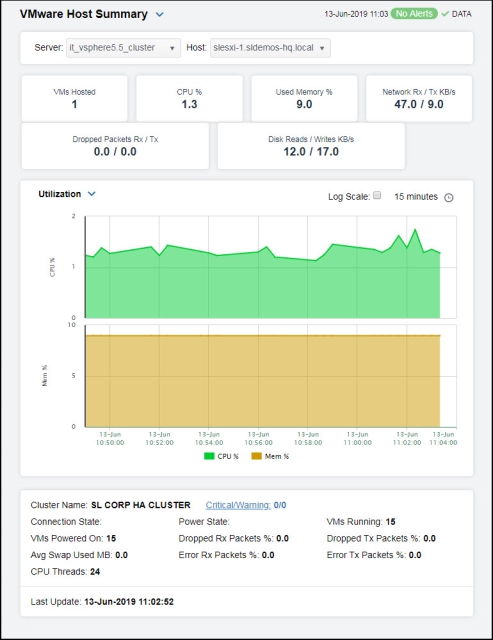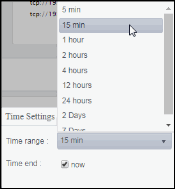VMware Hosts View
These displays present performance and utilization data for hosts running on one or all clusters and present utilization data for a specific host running virtual machines. Clicking VMware Hosts from the left/navigation menu opens the VMware Hosts Table display, which shows a tabular view of the utilization data for all hosts running on one or on all clusters. The option available under VMware Hosts is:
| • | Single VMware Host: Opens the VMware Host Summary, which shows utilization data for a specific host running virtual machines. |
VMware Hosts Table
View the utilization data for all hosts running on one cluster or on all clusters. Each row in the table contains data for a particular host. Click a column header to sort column data in ascending or descending order. Double-click on a table row to drill-down to the VMware Host Summary display and view metrics for that particular host.

Note: Fields/columns with an asterisk (*) at the end of the field/column definition contain data that is provided by the VMWare vSphere. Refer to VMWare vsphere documentation (http://pubs.vmware.com/vsphere-65/index.jsp#com.vmware.wssdk.apiref.doc/mo-types-landing.html) for more information regarding these fields
|
Filter By: |
||||
|
|
Server |
Select the server for which you want to view data. |
||
|
Hosts |
The total number of hosts of the selected cluster(s), which are listed in the table |
|||
|
Hosts Table |
||||
|
|
Server |
The name of the server. |
||
|
|
Host Name |
The name of the host. |
||
|
|
Alert Level |
The highest level alert on the host.
|
||
|
|
Alert Count |
The number of alerts currently on the host. |
||
|
|
Overall Status |
The general health status of the host.*
|
||
|
|
Connection State |
Lists the status of the connection.* |
||
|
|
Power State |
Lists whether the host is powered on or powered off.* |
||
|
|
In Maintenance Mode |
When checked, this check box signifies that the host is in maintenance mode.* |
||
|
|
Standby Mode |
The host’s standby mode.* |
||
|
|
Host Used CPU % |
The percentage of CPU used by the virtual machines.* |
||
|
|
Cores |
The total number of cores on the CPU.* |
||
|
|
CPU Threads |
The total number of threads on the CPU.* |
||
|
|
Host Memory Used % |
The percentage of the host’s memory currently in use.* |
||
|
|
Memory Used |
The total memory used, in megabytes, on the host.* |
||
|
|
Memory Size |
The total amount of memory, in megabytes.* |
||
|
|
Swap Mem |
The total amount of swap space used by the host, in megabytes.* |
||
|
|
Disk Reads KB/s |
The amount of data being read from the disk per second, in kilobytes.* |
||
|
|
Disk Writes KB/s |
The amount of data being written to the disk per second, in kilobytes.* |
||
|
|
Host IN KB/s |
The amount of network data being received per sec, in kilobytes.* |
||
|
|
Host OUT KB/s |
The amount of network data being transmitted per sec, in kilobytes.* |
||
|
|
Rx Dropped Packet % |
The percentage of incoming packets that were dropped.* |
||
|
|
Tx Dropped Packets % |
The percentage of outgoing packets that were dropped.* |
||
|
|
Rx Error Packets % |
The percentage of incoming packets that had errors.* |
||
|
|
Tx Error Packets % |
The percentage of outgoing packets that had errors.* |
||
|
|
Pkts IN |
The number of incoming packets.* |
||
|
|
Pkts OUT |
The number of outgoing packets.* |
||
|
|
Pkts IN Dropped |
The number of incoming packets that were dropped.* |
||
|
|
Pkts OUT Dropped |
The number of outgoing packets that were dropped.* |
||
|
|
Pkts IN Errors |
The number of incoming packets that had errors.* |
||
|
|
Pkts OUT Errors |
The number of outgoing packets that had errors.* |
||
|
|
Expired |
When checked, performance data for that cluster has not been received in the time specified in the Duration region on the RTView Configuration > (Project Name/MISCMON-LOCAL) > Solution Package Configuration > VMWare > DATA STORAGE tab. |
||
|
|
Time Stamp |
The date and time the data was last updated. |
||
VMware Host Summary
Clicking Single VMware Host in the left/navigation menu opens the VMware Host Summary display, which allows you to view the number of virtual machines running on a particular host, the most recent utilization data for the host, and the trend data for the host over a specified time range. Clicking on the information boxes at the top of the display takes you to the VMware Hosts Table display, where you can view additional host data.
In the trend graph region, you can select from Utilization, Disk, Network, or Network Loss. Utilization traces CPU and Memory usage percentage over a specified period of time. Disk traces disk reads, disk writes, CPU used percentage, and memory used percentage over a specified period of time. Network traces net transactions received and transmitted, as well as CPU and Memory usage percentage over a specified period of time. Network Loss traces the number of packets received and transmitted over a specified period of time.
Clicking the Critical/Warning link at the bottom of the display opens the Alerts Table by Component display.

Note: Fields/columns with an asterisk (*) at the end of the field/column definition contain data that is provided by the VMWare vSphere. Refer to VMWare vsphere documentation (http://pubs.vmware.com/vsphere-65/index.jsp#com.vmware.wssdk.apiref.doc/mo-types-landing.html) for more information regarding these fields.
|
Filter By: |
||||
|
|
Server |
Select the server containing the host for which you want to view data. |
||
|
|
Host |
Select the host of the virtual machines for which you want to view data. |
||
|
Fields and Data: |
||||
|
|
VMs Hosted |
The number of virtual machines on the host.* |
||
|
|
CPU % |
The percentage of average CPU used on the host.* |
||
|
|
Used Memory % |
The percentage of average used memory on the host. |
||
|
|
Network Rx/Tx KB/s |
The rate of network received and transmitted data, in kilobytes per second, by this host. |
||
|
|
Dropped Packets Rx/Tx |
The total number of dropped packets that were received and transmitted on this host. |
||
|
|
Disk Reads/Writes KB/s |
The rate of disk reads and writes, in kilobytes per second, on this host. |
||
|
Trend Graphs |
Utilization CPU Usage -- Traces the percentage of CPU used. Memory Usage -- Traces the amount of memory used. Disk Reads KB/s -- Traces the amount of data being read from the disk, in kilobytes per second. Writes KB/s -- Traces the amount of data being written to the disk, in kilobytes per second. CPU % -- Traces the percentage of CPU used. Mem % -- Traces the percentage of memory used. Network Net Rx KB/s: The amount of network data received per second, in kilobytes per second. Net Tx KB/s: The amount of network data transmitted per second, in kilobytes per second. CPU % -- Traces the percentage of CPU used. Mem % -- Traces the percentage of memory used. Network Loss Pkts Rx -- Traces the number of incoming packets that were dropped. Pkts Tx -- Traces the number of outgoing packets that were dropped. |
|||
|
|
|
Log Scale |
Select to enable a logarithmic scale. Use Log Scale to see usage correlations for data with a wide range of values. For example, if a minority of your data is on a scale of tens, and a majority of your data is on a scale of thousands, the minority of your data is typically not visible in non-log scale graphs. Log Scale makes data on both scales visible by applying logarithmic values rather than actual values to the data. |
|
|
|
|
Time Settings |
Select a time range from the drop down menu varying from 5 Minutes to Last 7 Days. By default, the time range end point is the current time.
To change the time range, deselect the now toggle, which displays some additional date fields. You can click the left and right arrow buttons to decrease the end time by one time period (the time selected in the Time range drop down) per click, or you can choose the date and time from the associated calendar and clock icons. You can also enter the date and time in the text field using the following format: MMM dd, YYYY HH:MM:ss. For example, Aug 21, 2018 12:24 PM. Click the now toggle to reset the time range end point to the current time.
|
|
|
Cluster Name |
The name of the cluster. |
|||
|
Power State |
Lists whether the host is powered on or powered off.* |
|||
|
Dropped Rx Packets % |
The percentage of incoming packets that were dropped.* |
|||
|
Error Rx Packets % |
The percentage of incoming packets that had errors.* |
|||
|
Critical/Warning |
The number of critical and warning alerts. |
|||
|
VMs Running |
The number of virtual machines currently up and running on the host.* |
|||
|
Dropped Tx Packets % |
The percentage of outgoing packets that were dropped.* |
|||
|
Error Tx Packets % |
The percentage of outgoing packets that had errors.* |
|||
|
Connection State |
Displays the current state of the connection for the host (connected/notConnected).* |
|||
|
VMs Powered On |
The number of virtual machines on the host that are powered on.* |
|||
|
Avg Swap Used MB |
The average amount of memory swapped, in megabytes.* |
|||
|
CPU Threads |
The number of CPU threads. |
|||
|
Last Update |
The date and time that the data in the table was last updated. |
|||







